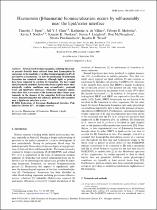 ResearchSpace
ResearchSpace
Haemozoin (B-haematin) biomineralization occurs by self-assembly near the lipid/water interface
JavaScript is disabled for your browser. Some features of this site may not work without it.
- ResearchSpace
- →
- Research Publications/Outputs
- →
- Journal Articles
- →
- View Item
| dc.contributor.author |
Egan, TJ

|
|
| dc.contributor.author |
Chen, JY-J

|
|
| dc.contributor.author |
De Villiers, KA

|
|
| dc.contributor.author |
Mabotha, TE

|
|
| dc.contributor.author |
Naidoo, KJ

|
|
| dc.contributor.author |
Ncokazi, KK

|
|
| dc.contributor.author |
Langford, SJ

|
|
| dc.contributor.author |
McNaughton, D

|
|
| dc.contributor.author |
Pandiancherri, S

|
|
| dc.contributor.author |
Wood, BR

|
|
| dc.date.accessioned | 2007-07-04T11:55:55Z | |
| dc.date.available | 2007-07-04T11:55:55Z | |
| dc.date.issued | 2006-09 | |
| dc.identifier.citation | Egan, TJ, et al. 2006. Haemozoin (B-haematin) biomineralization occurs by self-assembly near the lipid/water interface. FEBS Letters, Vol. 580(21), pp 5105-5110 | en |
| dc.identifier.issn | 0031-0182 | |
| dc.identifier.uri | http://hdl.handle.net/10204/968 | |
| dc.description | Copyright: 2006 Elsevier Science B.V | en |
| dc.description.abstract | Several blood-feeding organisms, including the malaria parasite detoxify haem released from host haemoglobin by conversion to the insoluble crystalline ferriprotoporphyrin IX dimer known as haemozoin. To date the mechanism of haemozoin formation has remained unknown, although lipids or proteins have been suggested to catalyse its formation. We have found that B-haematin (synthetic haemozoin) forms rapidly under physiologically realistic conditions near octanol/water, pentanol/water and lipid/water interfaces. Molecular dynamics simulations show that a precursor of the haemozoin dimer forms spontaneously in the absence of the competing hydrogen bonds of water, demonstrating that this substance probably self-assembles near a lipid/water interface in vivo. | en |
| dc.language.iso | en | en |
| dc.publisher | Elsevier B.V | en |
| dc.subject | Malaria | en |
| dc.subject | Lipids | en |
| dc.subject | Haemozoin | en |
| dc.title | Haemozoin (B-haematin) biomineralization occurs by self-assembly near the lipid/water interface | en |
| dc.type | Article | en |
| dc.identifier.apacitation | Egan, T., Chen, J., De Villiers, K., Mabotha, T., Naidoo, K., Ncokazi, K., ... Wood, B. (2006). Haemozoin (B-haematin) biomineralization occurs by self-assembly near the lipid/water interface. http://hdl.handle.net/10204/968 | en_ZA |
| dc.identifier.chicagocitation | Egan, TJ, JY-J Chen, KA De Villiers, TE Mabotha, KJ Naidoo, KK Ncokazi, SJ Langford, D McNaughton, S Pandiancherri, and BR Wood "Haemozoin (B-haematin) biomineralization occurs by self-assembly near the lipid/water interface." (2006) http://hdl.handle.net/10204/968 | en_ZA |
| dc.identifier.vancouvercitation | Egan T, Chen J, De Villiers K, Mabotha T, Naidoo K, Ncokazi K, et al. Haemozoin (B-haematin) biomineralization occurs by self-assembly near the lipid/water interface. 2006; http://hdl.handle.net/10204/968. | en_ZA |
| dc.identifier.ris | TY - Article AU - Egan, TJ AU - Chen, JY-J AU - De Villiers, KA AU - Mabotha, TE AU - Naidoo, KJ AU - Ncokazi, KK AU - Langford, SJ AU - McNaughton, D AU - Pandiancherri, S AU - Wood, BR AB - Several blood-feeding organisms, including the malaria parasite detoxify haem released from host haemoglobin by conversion to the insoluble crystalline ferriprotoporphyrin IX dimer known as haemozoin. To date the mechanism of haemozoin formation has remained unknown, although lipids or proteins have been suggested to catalyse its formation. We have found that B-haematin (synthetic haemozoin) forms rapidly under physiologically realistic conditions near octanol/water, pentanol/water and lipid/water interfaces. Molecular dynamics simulations show that a precursor of the haemozoin dimer forms spontaneously in the absence of the competing hydrogen bonds of water, demonstrating that this substance probably self-assembles near a lipid/water interface in vivo. DA - 2006-09 DB - ResearchSpace DP - CSIR KW - Malaria KW - Lipids KW - Haemozoin LK - https://researchspace.csir.co.za PY - 2006 SM - 0031-0182 T1 - Haemozoin (B-haematin) biomineralization occurs by self-assembly near the lipid/water interface TI - Haemozoin (B-haematin) biomineralization occurs by self-assembly near the lipid/water interface UR - http://hdl.handle.net/10204/968 ER - | en_ZA |





